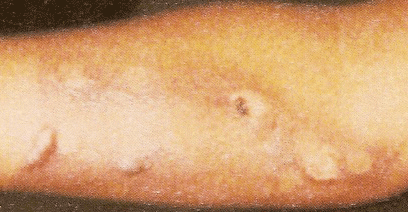 |
Physical Abuse
Physical Indicators
Physical abuse is often the most obvious form of abuse. It
is any non-accidental injury to a child by a parent or caretaker.
The mandated professional should pay close attention to any
frequent injuries that are "accidental" or "unexplained",
or that are developmentally unlikely or any explanation that
seems unlikely.
Physical abuse may present as (NYCACS, 2010; CDC, 2010;
CWIG, 2008; PCA-NY, nd; NYS-OCFS, 2005):
- Frequent and unexplained bruises
- On face, lips or mouth;
- On torso, back, buttocks, thighs;
- May be in various stages of healing;
- On several different surface areas of the body;
- May appear in distinctive patterns reflecting the
shape of the article used such as grab marks or human
bite marks, electric cord, belt buckle, etc.;
- Fading bruises or other marks noticeable after an
absence, weekend or vacation from school or day care.

- Burns
- Cigar or cigarette burns, especially on the soles,
palms, back and buttocks;
- Immersion burns (sock-lick, glove-like, or doughnut
shaped on buttocks or genitalia from having feet, hand
buttock/genitals immersed in scalding water);
- Distinctive patterned burn impressions from appliances
or instruments such as steam irons, curling irons, etc.;
- Rope burns on arms, legs, neck or torso.
Steam Iron Injury
 
 Handprint Injury Handprint Injury
 
 Looped Cord Injury Looped Cord Injury
 
- Cuts;
- Welts;
- Swelling;
- Sprains;
- Fractures
- To skull, nose, facial structures;
- In various stages of healing;
- Multiple or spiral fractures
- Swollen or tender limbs.
- Lacerations or abrasions
- To mouth, lips, gums, eyes;
- To external genitalia;
- On backs of arms, legs or torso;
- Human bite marks.
- Injuries to the eyes or both sides of the head or body
(accidental injuries typically only affect one side of the
body;
Child's Behavior - Possible Indicators of Physical
Abuse
The following behavioral signs do not necessarily mean that
a child is abused or maltreated, but should be considered
in light of other indicators. These behavioral indicators
are often general, potentially pointing to a problem that
may or may not relate to abuse/maltreatment.
- Wary of adult contacts; may shrink at the approach of
adults;
- Apprehensive when other children cry;
- May be overly afraid of the parent's reaction to misbehavior;
- Shows sudden changes in behavior or school performance;
- Has not received help for physical or medical problems
brought to the parents' attention;
- Has learning problems (or difficulty concentrating) that
cannot be attributed to specific physical or psychological
causes;
- Is always watchful, vigilant, as though preparing for
something bad to happen;
- Lacks adult supervision;
- Is overly compliant, passive, withdrawn or emotionless
behavior;
- Destructive, aggressive or disruptive behavior;
- Behavior extremes, such as appearing overly compliant
and passive or very demanding and aggressive or withdrawn;
- Comes to school or other activities early, stays late,
and does not want to go home;
- Uncomfortable with physical contact;
- Low self esteem;
- Lags in physical, emotional, or intellectual development;
- Seems frightened of the parents and protests or cries
when it is time to go home;
- Is either inappropriately adult (parenting other children,
for example) or inappropriately infantile (frequently rocking
or head-banging, for example);
- Has attempted suicide;
- Reports a lack of attachment to the parent;
- Reports injury by parent;
- Wears long sleeved or similar clothing to hide injuries;
- Seeks affection from any adult.
Parent's Behavior - Possible Indicators of Physical
Abuse
- Shows little concern for the child;
- Denies the existence of-or blames the child for-the child's
problems in school or at home;
- Takes an unusual amount of time to obtain medical care
for the child;
- Attempts to conceal the child's injury;
- Takes the child to a different healthcare provider or
hospital for each injury;
- Offers an inadequate or inappropriate explanation for
the child's injury;
- Offers conflicting, unconvincing, or no explanation for
the child's injury;
- Disciplines the child too harshly considering the child's
age or what s/he has done wrong
- Asks teachers or other caretakers to use harsh physical
discipline if the child misbehaves;
- Sees the child as entirely bad, worthless, or burdensome;
- Demands a level of physical or academic performance the
child cannot achieve;
- Looks primarily to the child for care, attention, and
satisfaction of emotional needs;
- Describes the child as "evil," or in some other very
negative way;
- Has a history of abuse as a child;
- Is unduly protective of the child or severely limits
the child's contact with other children especially of the
opposite sex;
- Is secretive and isolated;
- Is jealous or controlling with family members;
- Constantly blames, belittles, or berates the child;
- Is unconcerned about the child and refuses to consider
offers of help for the child's problems;
- Overtly rejects the child;
- Appears to be indifferent to the child;
- Seems apathetic or depressed;
- Behaves irrationally or in a bizarre manner;
- Has poor impulse control;
- Is abusing alcohol or other drugs.
Continue on to
|
 |